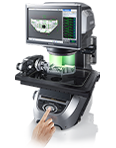Selecting by Measurement Target

- Transparency
- Shape
- Size
- Material
Is the shape simple or complex?
It goes without saying that the simpler the target shape is—such as with a rectangular solid or a circle—the easier it is to measure the dimensions. A wide variety of measuring instruments—such as rulers, tape measures, Vernier calipers, and micrometers—can also be used for these types of targets. For height measurements, these measuring instruments are used together with a height gauge or a dial gauge.
On the other hand, measuring the dimensions of targets with complex shapes, such as polygons and stars, is more difficult. The measuring instruments that can be used to measure such shapes are also limited. Optical comparators and image dimension measurement systems are best suited to measuring the dimensions of especially complicated shapes. In recent years, instruments have been developed with functions that make it possible to measure details such as the dimensions and angles of complicated shapes just by placing the target on the stage.
Is the material hard or soft?
When very hard targets such as metals and ceramics are pinched between the measuring components of hand calipers or a micrometer, the rate of target deformation is low, so measurement can be considered easy regardless of what measuring instrument is used.
However, when a soft object such as one made out of a synthetic resin is pinched between the measuring components of such instruments, the target will be deformed, making it difficult to perform measurement. In such situations, non-contact measuring instruments are very useful. For example, an image measuring instrument uses a laser light or similar light source to measure the dimensions in a non-contact manner.
Selecting according to size
Measuring microscopes are effective in measuring extremely small targets with dimensions in the micrometre scale or smaller. The operating principle of measuring microscopes is the same as with regular microscopes, and measurements can be performed in a non-contact manner, so there is no risk of damaging the target.
On the other hand, long scales are used to perform simple measurements of targets as large as a few meters, such as automobiles. A large CNC coordinate measuring machine can be useful for performing precise measurements.
Selecting according to transparency
A wide variety of measuring instruments can be used to measure opaque targets. However, some manipulation is required for measuring targets that have a high transmission ratio, such as when measuring the thickness of a transparent film. Micrometers and other contact-type instruments can measure transparent objects, but these instruments are not suitable for accurately measuring flexible objects such as films. On the other hand, laser displacement meters and other measuring instruments that use laser beams can perform accurate measurements in a non-contact manner.



